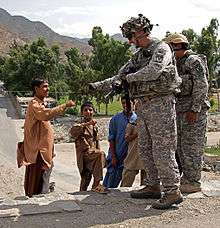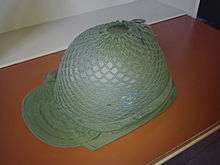Helmet cover


The helmet cover was first used by French soldiers during World War I.
Helmet covers are usually made out of canvas or cotton and come in many camouflage designs, for example: woodland, desert or urban, and different camouflage patterns like MARPAT, CADPAT and ACUPAT. It can also be used for UN peacekeeping missions with a UN Blue colour helmet cover. Helmet covers are generally a flat colour to stop any reflection from a metal helmet. Helmet covers are attached to the helmet in many different ways, such as a tight rubber lip which goes all the way around the helmet rim and is pulled on and peeled off, also there are versions with draw-strings and types which are attached to the helmet suspension system. The earliest helmet covers were retained simply by being "sandwiched" between the liner and the shell.
Helmet covers are used by most armies and are in the camouflage pattern of the country/military's camouflage pattern, but some armies do have different covers to the uniform, for example Austrian Bundesheer wear several different helmet covers and have not got one standardized cover for every soldier. The Israeli Defense Forces use a large, floppy helmet cover to break up the outline of the soldier. The US Army from the late 1950s to the mid-late 1980s used a dual-sided camouflage cover (one side a leafy green, the other a blobby orange) with its steel helmets while the rest of the uniform was green.
Another type of helmet cover is the mesh net cover, which also helps reduce the metal glare from combat helmets as well as giving an opportunity to add natural camouflage such as grass, leaves and twigs. This type of cover is however not as widely used anymore, as the modern camouflage cloth covers in various patterns are more common on modern combat helmets, and most cloth covers have cut-outs for placing foliage anyways.